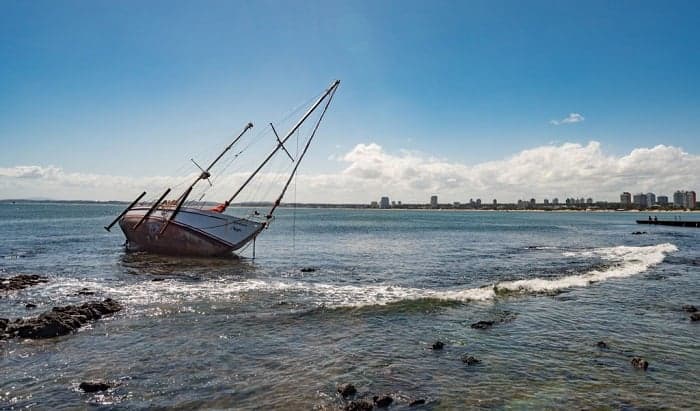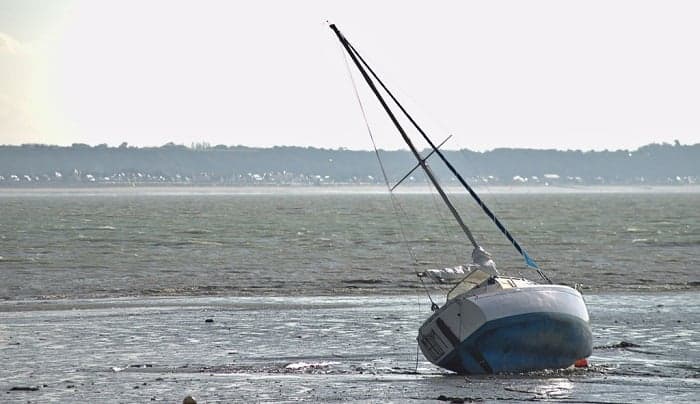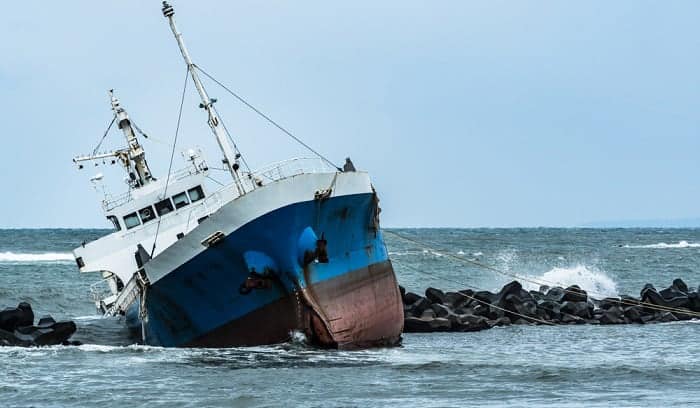No matter how careful you are, sooner or later, you can get stuck with your boat running aground. It can get worse when the situation induces anxiety and hints of danger.
Even experienced boaters seek answers to the EP-5 question, ‘What should you do first if your boat runs aground?’. First of all, you don’t have to try hard to push further. Instead, assess the circumstance and release an anchor or two if it’s manageable.
However, you may find yourself in a situation where anchors are futile. What’s best to do, in this case, is continue reading to know more and be prepared.
Table of Contents
- If Your Boat Runs Aground, What Should You Do First?
- How To Ask for Help
- Ways to Refloat Your Boat
- 1. Checking the Water Depth
- 2. Figuring Out the Next Tide
- 3. Lessening the Load
- 4. Slowly Pushing Off
- 5. Pushing with Combined Forces of the Passengers
- 6. With Kedge Anchor Line
- 7. Reversing Option
- 8. Rocking Back and Forth
- 9. Powering Off at an Angle
- 10. Taking Advantage of the Wake of the Passing Boat
- 11. Using a Dinghy to Pivot
- The Final Words to Set You Free From Being Aground
If Your Boat Runs Aground, What Should You Do First?
- Stop the engine and assess the state of your boat being grounded.
- Check everyone on board to see if anyone got hurt. A first aid kit can be handy in giving immediate remedies for injured people.
- If there are injuries onboard, call for medical assistance right away.
- Find the damaged parts, and they will likely be bilges and compartments. Some leaks and flooding may occur.
- When there are leaks and damages, you can stop them by mending with clothes, cushions, and other things on hand. However, this will only be a temporary solution; you still have to seek help.
- Immediate help is necessary when you’re grounded on a coastal reef or places with strong currents. Things can get worse real quick as you can’t always tell the changes on the tide. Thus, it’s considerably hard to recover your vessel without extra help.
- If no one is hurt and the boat doesn’t have damaged, you can do these things:
- You need to stop the tide from pushing the boat further to the ground. Do it by using the tender to put the anchor deep into the water.
- Observe the tide movements. If it’s rising, you’ll need to take it easy and wait for it to splash back on you. In this way, you can return to the water.
- In case of falling tides, you have to secure things that might fall due to its presence. Your boat will likely heel over and settle on its hull. You will need help when it happens. Typically, it takes 12 hours for the wave to rise and allow you to
How To Ask for Help
1. Through radio or signal
When your boat has a lot of damage, you can use a radio to reach the nearest vessel for assistance. Make sure that the driver who will tow your boat is experienced and knowledgeable.
2. Contact the Commercial Towing Company
It’s best to entrust a commercial towing company to take your boat back to the shore. They are experts in hooking your boat and towing it.
3. Radio the Coast Guard
You still need to radio the Coast Guard, although they’re not the designated people who do the towing. They should be notified that your boat has run aground and the location.
However, being stranded in a strong storm or when your boat is floundering is a different story. It’s time for the Coast Guard to get you and the passengers out of peril.
Ways to Refloat Your Boat
Again, you can try to make your boat refloat if there are no severe damages. Don’t be afraid to attempt by following these steps:
1. Checking the Water Depth
If your boat is not stuck in a grave manner, you can go ahead and check the water depth where your vessel has run aground. You’ll need to study the topography of the lake or sea bottom in this part. A chart and boat hook will help you with your search.
Then, a handheld depth finder or weighted line will allow you to determine the water depth. Obtaining this information will permit you to estimate if it’s safe to push off and identify the direction you have to go.
2. Figuring Out the Next Tide
One of the factors that will give you the best chance to make your boat afloat is figuring out the next tide. You can figure it out by checking the tide table. Remember that it’s a struggle if you push off your boat on shallow water with a low tide.
The ideal time to put your boat into the water is when there’s high water around you. In this setting, it will be impossible to run aground again when your vessel moves.
3. Lessening the Load
You can lessen the load in your boat by transferring some things onto a dinghy. Let the passengers transfer and unload heavy objects. You may also dump your water tanks and pump out your bilges.
Reducing the load in your is a way of giving your boat an extra lift to float effortlessly.
4. Slowly Pushing Off
When your boat is not grounded too far and you’re on soft ground, it will be easy to push off with an oar or boat hook. But before doing so, you need to lift the outdrive motor if it’s in your vessel.
As you keep on pushing, be mindful of any leakages and other damages. If there’s something wrong, you have to discontinue. Track your moves and avoid putting your boat into shallower water. Be wary of this as it can severely damage your propeller and rudder. If it happens, you will also need to worry about replacing them.
5. Pushing with Combined Forces of the Passengers
If pushing the boat with the help of an object doesn’t work, you can ask the passengers to get off the vessel and push the boat into high water.
6. With Kedge Anchor Line
If you struggle when pushing your boat to the shore, use the kedge anchor line to haul your vessel back to the water. This process can generate more force that helps the grounded boat to move.
7. Reversing Option
Be smart with your judgment if you can reverse with the help of the engine power. However, there’s a downside to this option. When you use your engine after the boat has run aground, it collects debris that causes overheating and clogging.
Even so, your engine can help you get out of being stuck. It’s the option that you can try if pushing fails to work. The bow is usually the boat’s part that runs aground. Thus, it shouldn’t contain much weight.
If you opt for this, the passengers should vacate the bow and proceed to the stern. After you turn on your engine, put it in reverse to see if you can release your boat.
8. Rocking Back and Forth
This step will work for vessels with two engines. The alternate surge of power on the sides of the boat can sway it back to deeper water. You can also try it with boats that have a single engine. It’s the rudder that you need to move side to side to bring about the same effects.
When your boat is grounded at an angle with two engines onboard, you can direct each of them to move differently. You can use one to go forward to the shore and the other to reverse and turn the boat. This way, you will ultimately free the boat.
9. Powering Off at an Angle
This is what you need to do if you run aground at an oblique angle. Don’t do this step if you’re not in the said situation. If you’re not at an angle and you still follow this, you’ll only find yourself more firmly aground.
But if you’re in the right circumstance, you can turn on your engine to move forward. The rudder should be deeper into the water at the same time.
10. Taking Advantage of the Wake of the Passing Boat
The wake of the passing boat can help you pull your boat up. However, this is only the best thing to do if you’re over a soft bottom and haven’t run aground too far. The timing of the wake should be in harmony with the engine thrust to deliver an extra boost to your boat.
11. Using a Dinghy to Pivot
It can be risky but it’s deemed effective, and it’s only exclusive to experienced boaters. Also, it works well when being aground at an angle. If you apply this process, the deeper water is on the boat’s side, not directly astern.
You can use the dinghy to push the bow into the deeper water. You shouldn’t settle for this as your first option because it’s a complicated action. It can damage the hull as well as the dinghy. You can try other options before resorting to this.
The Final Words to Set You Free From Being Aground
As a boater, you should prepare for running aground as everyone can experience this. Never panic and educate yourself on what should you do first if your boat runs aground.
Make sure you have the tools on board in case your boat gets stuck. Be wise and try the simple option first. Then, analyze the situation to pick the right solution as there will be instances when you need help from others.

“I am James Harvey – founder of Boating Basics Online. It is established with the drive to help out first-time boaters, which are those desiring to explore their way through the water. So if you are new to boating, start from here with me. “



